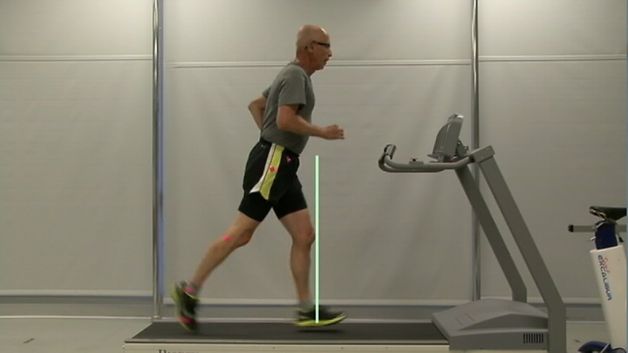
It was early in the evening and I just happened to look outside the windows at the front of our house. You can see our neighbours’ house almost directly across the street and our front garden. As I looked, I noticed a woman dressed in cargo pants, T Shirt, baseball cap and joggers standing outside the front of our neighbours’ house on the pavement. Nothing unusual about that, except there was something a little odd in the way she was standing. She was facing down the street leaning forward as if bracing against the wind – and the air was still.
As I watched she started moving, her whole body becoming propelled as she started to run. As she ran, the momentum of her pace and the angle of her body made it appear as if she might suddenly fall forward flat onto her face. Somewhat alarmed I thought perhaps I had better go and check she was O.K, but then after 10 -12 steps she stopped, became motionless again and the whole scenario repeated itself, and again, and again.
At first I was puzzled and then it dawned on me what was happening. This lady had a neurological deficit, probably Parkinson’s disease. This was her way of getting out to do some exercise, in this apparently tortuous fashion. I still see her periodically now and again doing her stop-start runs. She appears to choose a time when not too many people may be out and about and I admire her tenacity and perseverance in continuing to choose to exercise against the odds.
Parkinson’s disease is the second most common neurological deficit (after Alzheimer’s disease). It is a progressive disorder of the nervous system and tends to occur after the age of fifty. Michael J. Fox is the American actor now perhaps better known for his continuing struggle with this condition.
People often associate Parkinson’s disease with tremor, the well recognised “pill-rolling” tremor at rest that often affects the hands. But what may be less well known are the other symptoms, which include stiffness and slowing of movement. A person’s face may lose its expressiveness – so they appear more “poker faced”. Having rigid muscles can make it uncomfortable to move and reduce your range of movement as well. Balance can become an issue too – hence this lady’s precarious appearance of not being able to stand straight. Initiating movement starts to require more effort as demonstrated by this lady’s obvious hesitation every time she wanted to start moving/running again.
A gentleman who has been living with the condition for a number of years recently asked me about exercise for people with Parkinson’s disease. He was already undertaking gym sessions two to three times a week, but wanted to know what else he could do to improve things. This got me thinking as I thought well, he is already going to the gym and doing a supervised, structured program, so the most important thing is simply to keep going.
Which it is, but I then came across some studies investigating which exercises were best specifically for people with Parkinson’s disease.
Lisa Shulman from the University of Maryland explains that treadmill exercise and resistance exercise are both good for reducing symptoms of Parkinson’s disease, but that different types of exercise improve different symptoms. In particular treadmill exercise is good for cardiovascular fitness, resistance exercise improves muscle strength and the combination improves gait speed and mobility.
Retaining mobility and function is the primary goal here. If exercise can help then this is likely to make you feel that are doing something good for yourself.
In the study the researchers compared using a treadmill at high intensity (30 minutes at 70-80% of heart rate reserve) vs. low intensity (50 minutes at 40-50% of heart rate reserve) and stretching and resistance exercise (2 sets of 10 repetitions on each leg on a leg press, leg extension and curl machine).
The study continued over a three month period with all the participants training x3 a week for a total of 36 sessions.
What they found surprised them:
It was the low intensity treadmill exercise that yielded the greatest benefit (12% improvement for gait), where the participants had basically been walking at a comfortable pace.
It was thought perhaps the duration i.e. the 50 minutes of exercise might be relevant.
The stretching and resistance training was certainly useful for improving muscle strength (16% improvement) and the high intensity workout showed benefit for gait too, but to a lesser degree.
The message appears to be that for Parkinson’s disease maintaining function and mobility can be assisted by structured and supervised exercise. It is probably important to stress that for anyone with Parkinson’ s disease it would appear to prudent to check in with their primary physician or G.P first before instigating their own program.
So the next time I get asked about exercise for someone with Parkinson’s disease I now have a clearer answer. But I also want to find out more about the role of swimming here.
Meanwhile I shall look out for the lady down the street and when I next see her going out for her run, silently cheer her on.
Ref:
Shulman LM, Katzel LI, Ivey FM, et al. Randomized Clinical Trial of 3 Types of Physical Exercise for Patients With Parkinson Disease. Arch Neurol. 2012;():1-8. doi:10.1001/jamaneurol.2013.646.


